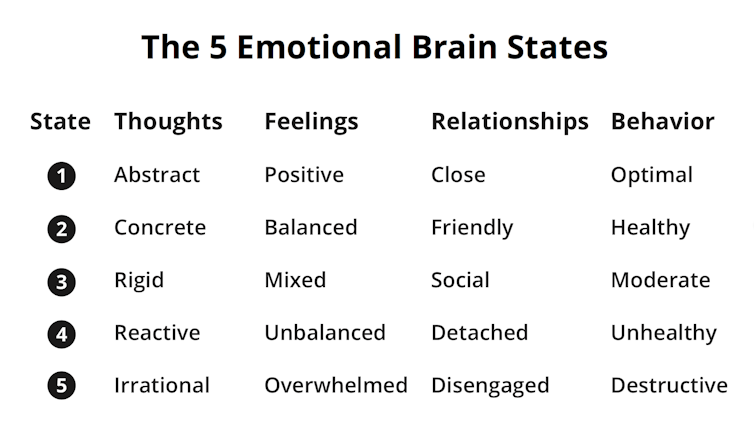Stressed out by shutdown chaos? 4 evidence-based tools to help you cope
- Written by Laurel Mellin, Associate Clinical Professor of Family & Community Medicine and Pediatrics, University of California, San Francisco
Despite the short-term relief from the government shutdown, there’s a growing feeling that what appears to be political chaos in Washington is rippling across the country.
People needn’t try to escape the stress. In fact, in stressful times, we can update how our brain copes with daily chaos and stress overload, and boost our natural capacity for resilience using neuroscience[1].
After more than three decades of studying the brain under stress and with my colleagues at University of California San Francisco, I have found that advances in neuroplasticity[2] are showing us how to make the “lemons” we all face during stressful, chaotic times into lemonade by training the brain[3] to recover from stress overload faster. The following four tools are my picks to enhance your resilience.
Tool 1: Identify your stress number
When the brain is under stress, it activates circuits that trigger the fight-or-flight response[4]. These circuits reside in the emotional brain, or “unconscious mind,” and are activated without our permission. They charge up drives to repeat old responses[5] that can trigger a spiraling down into dysfunction. Or they can trigger a spiraling up into equanimity, love and purposeful action. Brain-based stress management involves strengthening the dominance of the wires that promote healthy coping, so the brain becomes wired to favor spiraling up.
Rapid-fire change during periods of extreme uncertainty causes strong emotions to kick in. In a period of extreme and prolonged stress, the brain’s set point[6], its default stress level, declines. Stress becomes chronic and unrelenting. If our set point slips enough, the default brain area in charge is no longer the sensible neocortical brain, the prefrontal cortex, which integrates emotions and thoughts and finds wise compromises and “win-wins.”
Instead, the emotional brain that houses the stress center, the amygdala, takes control, signaling emotional shut downs and overreactions. The shared stress load of modern life may be moving us collectively into the “age of the emotional brain” when our “normal” setpoint activates physiologic stress overload.
By checking in to identify the stress level of the brain, we can more accurately predict and control our responses in daily life.
To take charge of stress, thinking our way out of problems is not effective[7]. We’re better off identifying our “brain state.” The first step in emotional brain training[8] is to assign a number to the stress we are feeling, using a scale of one to five, with one being optimal. To determine our number, we check to see how we are feeling and functioning in several areas of life, then use this neurophysiologic “tag” of our state for more rapid stress reduction[9] and to appraise our functioning more accurately.
 The EBT 5 Point System for emotion regulation.
Laurel Mellin,EBT
The EBT 5 Point System for emotion regulation.
Laurel Mellin,EBT
Tool 2: Use damage control
When multiple levels of extreme change and discords settle into our unconscious mind, we go to “Brain State 5.” In this state, the neocortex goes on holiday, and the reflexive circuits of the emotional brain silently distort our emotions, thoughts, relationships and coping behaviors. We know we should not make important decisions, take rash actions or blame others in that state. All three are almost impossible to avoid because the amygdala is in control, which is why using this damage control tool is our first defense.
The damage control tool starts with three evidence-based techniques for decreasing physiologic stress: diaphragmatic breathing[10], or breathing deeply into your belly; proprioceptive posturing[11], or what some have called “good posture with a smile;” and decentering[12], or observing yourself. Then it repeats messages that counteract the fight-or-flight messages to judge, harm and believe all is lost: Do not judge. Minimize harm. Know it will pass.
Tool 3: Honor that you are the solution
 Humans can find a way to be peaceful in the midst of stress, but it takes practice.
karelnoppe/Shutterstock.com[13]
Humans can find a way to be peaceful in the midst of stress, but it takes practice.
karelnoppe/Shutterstock.com[13]
When the drive to align with one side or the other ramps up during confusing and heated times, appreciate that we humans do have power to connect with the deepest part of ourselves and determine what we believe – in all its complexity.
This is hard to do, because stress is contagious[14]. The emotional brain has no walls. Walk into a room of stressed people and their brain circuits of stress overload can instantly enter your brain circuitry, activating a cascade of stress circuits that cause anxiety, depression, procrastination and common excesses. Their stress can infect you with the polarization and induct you into their inner world of emotions and expectations. The brain’s natural drive to be like others for primordial safety – we are tribal – can amplify that toxicity.
Although we can surround ourselves with loved ones, accepting our separateness is vital to development. Of the seven circuits of basic expectations that help us evolve, the first is facing that we are responsible for our lives. An emotional brain training tool that helps us focus inside and trust[15] ourselves involves repeating several simple statements: I do exist. I am alone. My reward for accepting that: a new sense of peace and power from within.
The neurologist Victor Frankl[16] asserted that everything can be taken away from a person, but our last freedom is “to choose our own way.” We can make that choice most effectively when we are at Brain State 1, as it is the state of neural integration[17], when the emotional brain is not ruling us. We are cognitively effective and draw upon our wealth of emotional circuit activations that encourage us to be our wisest and best selves.
The power of one person is all we have, and from that secure connection to ourselves, we can move past the numbing passivity or misguided aggression to a place of equanimity, assertion and engagement in effective change.
Tool 4: Identify your higher-order reward
Our survival brain not only drives us to avoid stress but also demands that we feel rewarded[18]. The two high-reward states are Brain States 1 and 5. When we are at Brain State 1, we access love, compassion, gratitude, hope, forgiveness, awe and joy. When we are at Brain State 5, the neocortex and emotional brain split[19], and we cannot access those rewards; instead we reward ourselves with common excesses, artificial pleasures and everyday addictions and compulsions.
Whether we use contemplation, prayer or emotional processing tools, the brain-based solution to stress is to find our way to Brain State 1, then bring to mind one of the higher-order rewards, upon which rests the survival of the species, such as integrity, authenticity, intimacy or freedom. Projections between the neocortex and emotional brain will deliver a burst of dopamine and endorphins to the brain’s reward center. It will swamp stress and boost our capacity to think clearly and take balanced and effective action.
A moment of opportunity
 When people feel peaceful, they are more likely to be able to help other people and to contribute to life.
Maridav/Shutterstock.com[20]
When people feel peaceful, they are more likely to be able to help other people and to contribute to life.
Maridav/Shutterstock.com[20]
Stress can be good for us because only then can we heal old wounds and update our most fundamental expectations about life. Emotional neuroplasticity[21] – being present to our emotions during stress and using our neocortical mind and unlocking the synaptic connections of neurons and updating our circuits[22] – is at the forefront of brain plasticity research. Often, in moments of stress when we have a flash of emotion we can change our circuitry, which is the neuro-biological basis for both “bottoming out” and personal transformation.
Even though the shared stress we face now can be overwhelming, it is also a time of profound possibility. Imagine if we used the situation of the shutdown to update how we think about stress and take it as a challenge to improve brain function by getting to Brain State 1 more often. As the primitive brain evolved to instantly read the unconscious intentions[23] of others – friend or foe, higher-order reward or lower-order reward – in order to survive, our unconscious expectation of higher order rewards not only changes our day, but can be experienced by others.
We give back in a special way. Even if we disagree with others, by unconsciously transmitting to them our fundamental expectations of higher purpose, we may infect them with those caring, connecting expectations, changing their brain one neural circuit at a time. Perhaps we cannot agree on policies, but we can agree on purpose.
By taking really good care of our stress – and our brain state – we can change own inner world and change the world as well. In fact, in the age when the emotional brain is fast becoming our societal controller, that could be the solution that we’ve been seeking.
This is an updated version of an article that was published originally July 19, 2018.
References
- ^ neuroscience (www.ncbi.nlm.nih.gov)
- ^ neuroplasticity (www.ncbi.nlm.nih.gov)
- ^ training the brain (www.ebtconnect.net)
- ^ fight-or-flight response (www.ncbi.nlm.nih.gov)
- ^ repeat old responses (www.ncbi.nlm.nih.gov)
- ^ set point (www.ncbi.nlm.nih.gov)
- ^ effective (www.ncbi.nlm.nih.gov)
- ^ emotional brain training (www.ebtconnect.net)
- ^ stress reduction (www.amazon.com)
- ^ diaphragmatic breathing (www.ncbi.nlm.nih.gov)
- ^ proprioceptive posturing (www.ncbi.nlm.nih.gov)
- ^ decentering (www.ncbi.nlm.nih.gov)
- ^ karelnoppe/Shutterstock.com (www.shutterstock.com)
- ^ contagious (www.ncbi.nlm.nih.gov)
- ^ trust (www.ncbi.nlm.nih.gov)
- ^ Victor Frankl (www.amazon.com)
- ^ neural integration (www.ncbi.nlm.nih.gov)
- ^ feel rewarded (www.annualreviews.org)
- ^ brain split (www.ncbi.nlm.nih.gov)
- ^ Maridav/Shutterstock.com (www.shutterstock.com)
- ^ Emotional neuroplasticity (www.hypothesisjournal.com)
- ^ updating our circuits (www.ncbi.nlm.nih.gov)
- ^ unconscious intentions (www.ncbi.nlm.nih.gov)
Authors: Laurel Mellin, Associate Clinical Professor of Family & Community Medicine and Pediatrics, University of California, San Francisco

